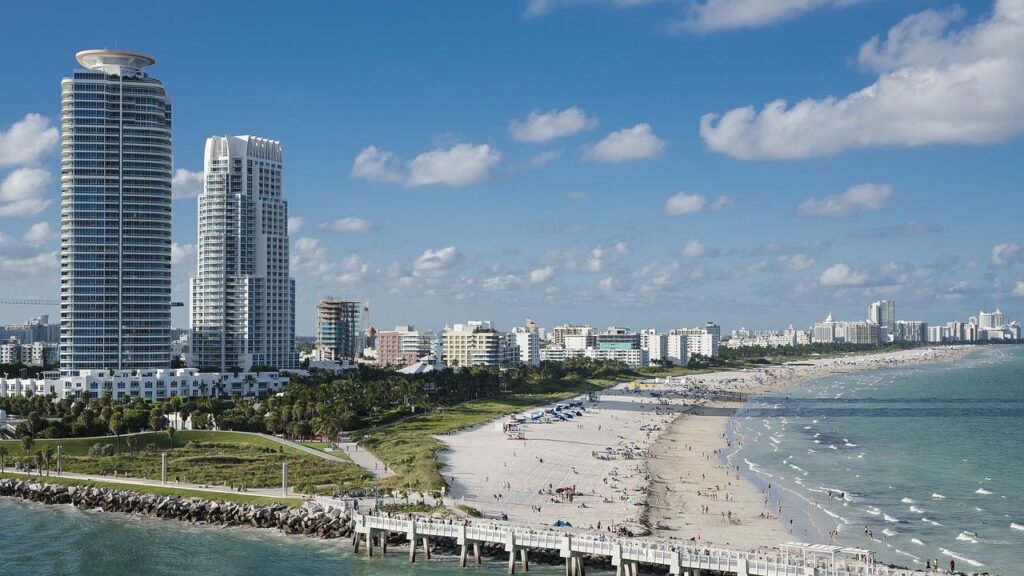Miami, FL, is a complete package of beaches, a vibrant atmosphere, and a fast-paced life.

The glamour of this town makes it a desirable location for many people. Famous worldwide for its lively crowd, Miami has a little bit of everything, making it a perfect place for anyone to start anew.
However, despite being one of the most ideal locations to live in America, Miami is no stranger to some downsides either!
So, before you lose yourself in the thoughts of surfing along the wavy beaches of Miami, it’s necessary to stand back and consider the pros and cons of the town, which is where this guide fits in.
So, without any further ado, let’s check the pros and cons of living in Miami!
SEE: 10 Pros and Cons of Living in Tampa, FL
Contents
Pros of Living in Miami
Ideal Weather
Miami boasts sunny weather all year, perfect for leaving behind the cold weather of the north. During the winter season, the temperatures peak at 70. The average daily temperature in Florida ranges between the mid-60s to lower-90s.
The weather in Miami stays constant, suppressing the element of surprise. Miami weather induces a breezy and warm temperature, making life more enjoyable.
The ideal weather conditions go hand in hand with the many attractions in Miami. The sunny weather is perfect for exploring the city’s recreational activities and entertainment options. But hey, remember the hat and sunblock because skin burns still happen!
Diversity
As people from different ethnicities call Miami home, Miami is a boiling pot for various cultures. The Americans regard Miami as an international city, given the town’s high diversity.
The statistics conclude that more than 70% of Miami residents belong to either Hispanic or Latino ethnicities. As you move to Miami, you will experience cultures from different countries, including Cuba, Costa Rica, Argentina, and Colombia.
The indulgence of this colorful culture into the city’s fabric shapes Miami’s lifestyle into an interesting one. People from different cultures bring a taste of their hometowns through a diverse menu and arts. In short, Miami inherits a unique, diverse experience that remains unmatched by any other city.
Beaches
We won’t be surprised if Beaches are the first thought that comes to your mind when you hear “Miami.”
Miami’s beaches are renowned for their soft sand and crystal-clear water. The many beaches of Miami make for a great picnic spot and are perfect for spending the weekend. You can partake in various activities, including surfing, swimming, fishing, or sunbathing.
The coastal vibe inherited by Miami makes it one of the “Heaven on Earth” destinations. According to Greater Miami Convention, top Miami beaches include:
- South Beach
- North Beach
- Surfside
- Haulover Beach
A Strong Job Market
Miami is a major international port, resulting in companies opening manufacturing facilities and trade industries in the city. The presence of many banks and investment firms in the city strengthens the city’s financial district.
The presence of so many companies in the city results in many jobs available.
Depending on where you choose to move from, Miami can be a great city to advance your professional career. The competitive job market also ensures well-paying jobs, allowing you to receive fair compensation for your hard work.
According to American Van Lines, the top industries in Miami include:
- Tourism
- Finance
- Media and Telecomunications
- Trade
Much to Do
Miami is renowned all around the world for its beaches and exciting nightlife. While these aspects make life in Miami exciting, there are other things to look up to. Miami has something lined up for everyone.
As you move to Miami, you will discover the many recreational activities in town. Additionally, there are many places to explore art, such as art museums and theatres.
There are many eateries available in the city. Given that Miami has a high diversity, moving to Miami is your chance to taste cuisines worldwide.
According to Time Out, the best things to do in Miami include:
- Attend The Formula 1 Grand Prix
- Attend SunFest
- Air & Sea Show
Cons of Living in Miami
Crowded!
While the attractions and beaches allow the residents to enjoy living in Miami, tourists worldwide are always looking for a taste of the Miami Lifestyle too!
Unlike other cities like Myrtle Beach, Miami welcomes tourists throughout the year, but the beaches can get crowded during the winter and fall months.
The ideal weather conditions during these months draw in visitors to explore the scrumptious lifestyle of the city.
During these times, it can be very difficult to find restaurant reservations or attend a concert of your favorite artists touring your hometown.
High Cost of Living
Considering the amenities, and the attractions, it goes without saying that Miami is an expensive town to live in.
The living costs in the city are 21% higher, whereas the housing costs in Miami sit 47% higher than the national average. The high housing costs also mean that you will have difficulty finding a house at an affordable cost.
On the other hand, healthcare in Miami is also very costly. While buying health insurance is a lucrative method to receive healthcare, insurance doesn’t make much difference in the total costs.
So, only consider relocating to Miami if you can afford it. If you make $23 an hour, then Miami is not a place for you.
You will need to earn a significantly high amount to keep up with all the expenses and create an extensive budget.
Traffic
Miami is notorious for its traffic congestion and long commute times, which can be a significant downside for those living in the city. The city is consistently ranked among the worst in the United States for traffic.
The high volume of vehicles on the road, coupled with the regular influx of tourists unfamiliar with the area, can lead to frustrating and time-consuming travel experiences.
Rush hours in Miami can be particularly grueling. Morning and evening commutes often involve bumper-to-bumper traffic, leading to extended travel times. Even short distances can take a long time to travel during peak hours.
This issue is further compounded when there are special events, road construction, or accidents, which can lead to even longer delays.
Public transportation in Miami includes buses, trolleys, and a metro rail system. While these options are available, they are often criticized for their inefficiency, unreliability, and lack of extensive coverage.
Therefore, many residents are dependent on their cars for commuting, despite the associated challenges.
Language Barriers
While Miami’s rich Latin American culture contributes to its unique charm, it also means that Spanish is widely spoken throughout the city.
In fact, according to some reports, Miami is the second largest U.S. city with Spanish-speaking residents, second only to El Paso, Texas. While this multicultural environment can be an enriching experience, it can also present language barriers for those who do not speak Spanish.
In certain neighborhoods, you might find that Spanish is more commonly spoken than English. This is especially true in areas like Little Havana or Hialeah, where the majority of residents are of Cuban descent.
In such areas, even mundane tasks like shopping, dining out, or interacting with service providers could become challenging for non-Spanish speakers.
In the professional context, individuals who are not bilingual might find fewer job opportunities, particularly in customer service roles that require interaction with the local population.
Even in social situations, the language barrier might limit the depth of one’s engagement with the local culture and community.
Crime rate
Miami has a relatively high crime rate compared to the national average in the United States, particularly when it comes to property crimes such as burglary, theft, and vehicle theft.
The city’s vibrant nightlife and tourist appeal also make it a target for crimes like pickpocketing, especially in crowded tourist areas and on public transportation. Violent crimes, including assault and robbery, also occur, though they tend to be concentrated in certain neighborhoods.
Of course, crime isn’t equally distributed across the city. Miami is a city of neighborhoods, each with its own unique character and safety levels. There are plenty of neighborhoods in Miami that are considered quite safe and have a strong sense of community.
While crime can happen anywhere, and many residents of Miami live there without being affected by crime, it’s still a factor to be aware of. This is particularly true if you’re moving from a place with a significantly lower crime rate.
Final Words
Like any city, Miami has its good and bad sides but in general, it is a great place to live, especially for young people. However, for families, there are quite a few downsides to consider.

Hi, I’m Ashley a freelance writer who’s passionate about personal finance. Ever since I was young, I’ve been fascinated by the power of money and how it can shape our lives. I’ve spent years learning everything I can about budgeting, saving, investing and retirement planning. So if you are looking for tips, advice, or just a little bit of inspiration to help you on your financial journey, you have come to the right place. I am always here to help, and I am excited to share my passion for personal finance with you.
